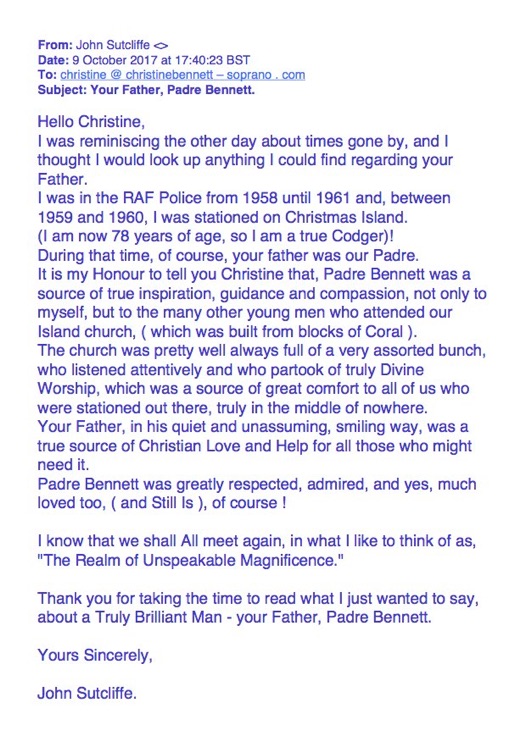Stanley G Bennett 1915 - 1980


My interest in music, and especially singing, was always fostered by my father. I had promised myself that, one day, I would create some sort of tribute to him: a person who demonstrated that even “ordinary” folk can do extraordinary things in, and with, their lives.
He was born in Handsworth, part of the Birmingham area, in 1915, the second son of Leonard and Alice Bennett. Leonard was the youngest child of a corporation labourer, who had died in 1898, when Leonard was only 10; and Alice was the fourth child of Jason Warr, a thatcher, and lay preacher in the Congregational Church. Leonard, himself, had worked in a tailor’s shop as a youngster, but had gone on to work his way up in the Birmingham Tram Company, eventually becoming a driver. For whatever reason, Leonard decided to walk out on his young family in May 1916 (about the time that WW1 conscription was extended to married men), emigrating to Canada at first, and then moving on to Detroit and, eventually, to Florida, where he died in 1967. Alice was left with little option but to put Stanley’s older brother into an orphanage, and send her baby son, Stanley, to live with her parents, while she tried to earn some money to make ends meet.
Although there were tenuous rumours of his having gone to the USA, Alice and her family regarded Leonard as dead to them (for example: my parents’ wedding certificate records him as “HM Forces 1914-18, deceased”) and, in 1923, Alice married again to a widowed doctor - an undoubted move “up” in the world. Sydney Billington seems to have been a stepfather of quality: he put both his stepsons through an education of which they could hardly have dreamt had their own father stayed with the family: prep school, Stratford-on-Avon Grammar School, and then university. The clearest evidence of his positive influence must be their educational choices: Stanley’s elder brother had chosen medicine, and Stanley, himself, biochemistry, with the intention of helping his stepfather with his research into blood cancers.
Stanley’s memories of school seemed to revolve around sport: anything involving trajectory seemed to be natural for him, whether it was football, cricket, rugby, golf, tennis... and he had a strong competitive streak and a wicked sense of humour, a combination which made him a formidable opponent in croquet! His interest in music must have been nurtured by his beloved mother, who was a solo soprano singer. Stanley spoke of times spent around the piano, with his mother playing and singing. His own piano lesson experience was less delightful: a tartar who rapped his knuckles whenever he made an error. It is no surprise that he dropped piano lessons, although he retained the ability to “vamp” - playing “by ear”. Tragically, Alice died of a brain tumour in 1927, when Stanley was only 11. Sydney Billington married Alice’s older sister, Annie. The favourite aunt turned into a less successful stepmother and Sydney, himself, died in 1934. Sometime after this, the two brothers underwent successive conversions: having vowed never to set foot in church again after having been “frogmarched” to church three times a Sunday during their boarding school years at Stratford, both of them experienced the call to become clergy in the Church of England.
Stanley studied in London, and was invited to visit a fellow student in his curacy in Portsmouth. While there, he met Jeanne, who was later to become his wife. Just as Stanley’s mother had died young (aged only 40), so had Jeanne’s, so perhaps there was some kind of resonance in their upbringing. It was during his time in London that he spent some time on the ground staff of Arsenal. He learned a lot about football training - and became a lifelong supporter.
He had always been good at reading aloud - winning prizes at school, both for that and for sport. This useful skill was carried over into his theological training. He was a good student, although he was so modest about his abilities that when he went into the college to see the results of his finals he thought he’d failed... until fellow students drew his eyes to the top of the list, amongst the Firsts!
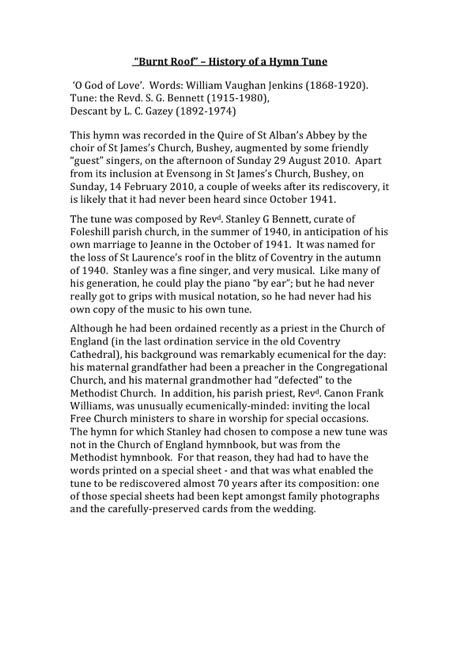
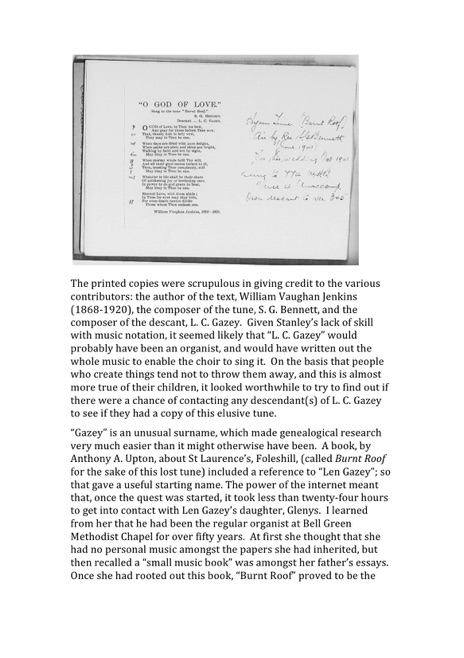
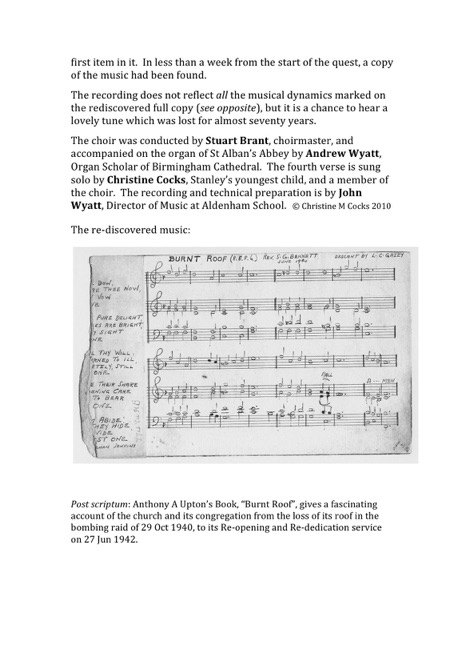
From Coventry, Stanley went on to Portsmouth Diocese in 1943, becoming precentor at the (relatively new) cathedral there in 1945. His entertainment skills, which had been so valuable in the fundraising for Foleshill, were now harnessed by the Bishop of Portsmouth for his own appeals for special fundraising. (There are references to this here: The Portsmouth Music Scene, in the 1947 page.) In the Pompeydours, rather than his piano playing, it was his singing to his own banjolele accompaniment which came to the fore - along with his stagecraft for humorous sketches. There are hair-raising anecdotes of coming out from a performance to find that, at some point during the performance, an unexploded flying bomb had lodged itself in a tree outside the venue.
After expending a considerable amount of time and effort in convincing the Bishop that the RAF was at least as in need of clergy as the nearby Royal Navy, Stanley was allowed to move on in 1947 to become an RAF chaplain. He had already been chaplain to a balloon squadron. There followed postings all over the world - with his growing family usually taking the chance to come along, too.
One of his early postings was to Aden. According to my mother’s notes, in 1949 he was temporarily based on Mukalla in the Hadhramaut on the Indian Ocean coast. While there he had a body guard from the Bedouin Legion - a man who respected my father sufficiently to want to exchange marks of religious faith - taking my father’s chaplain's badge, and offering his Q’ran arm-bangle in return - a bangle we still have.
In the mid-1950s, he was posted to RAF Laarbruch. While there, he and Jeanne took part in amateur dramatic productions - bringing the house down in his rôle of “Clive”, old flame of the vicar’s wife (played by Jeanne), in “See How They Run” as he called out, incredulously, “What? You? A Vicar’s wife?!”
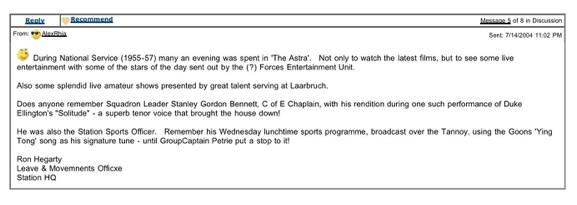
Stanley was ordained deacon in Holy Trinity, Coventry, in 1939, and then priest in the Cathedral on Trinity Sunday of 1940 - the last ordination service before the firebombs of the autumn wrecked the building irrevocably. The next part of the story - about a very special hymn-tune - is recounted in the following images, devised as a booklet to accompany a private CD.
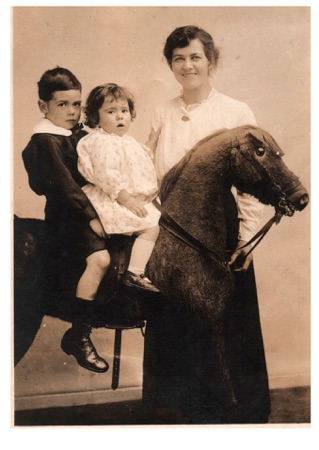
Stanley with his elder brother, George, and his mother, Alice - ca 1917
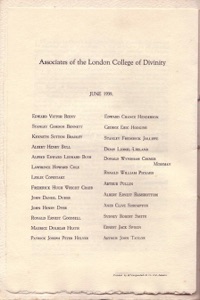
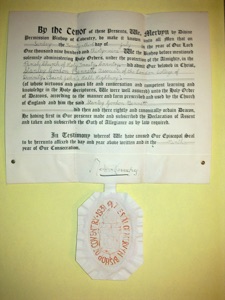
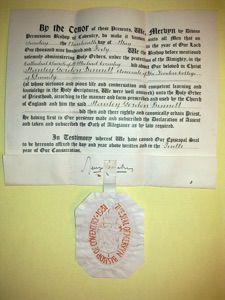
About Stanley
Born Oct 1915 Handsworth
1916 - father walked out on the family
1923 - mother, Alice, married again
1927 - 1928 Solihull (Grammar) School
1927 - mother died
1928 - 1933 Stratford-on-Avon Grammar School
1930 - stepfather married Alice’s elder sister
1934 - stepfather died
University, studying bio-chemistry
to 1939 London College of Divinity
Deacon 1939 Coventry
Priest 1940 Coventry
1939 Curate, St Lawrence, Foleshill
Married Oct 1941
1943 Curate, Fareham
1945 Precentor, Portsmouth Cathedral
1947 - 1970
RAF Chaplain
Sqdn Ldr until 1962, then Wing Cdr.
Postings included:
Cosford
Khormaksar
St Athan
Laarbruch
Halton (1 Wing)
Christmas Island
Wittering
Newton
Butzweilerhof
Watton
Catterick
1970 - 1978 Rector of Priory Cross Group, West Norfolk, Ely Diocese
1978 - only brother died
1978 - 1980 Rector of Gamston with Eaton and West Drayton, North Nottinghamshire, Southwell Diocese.
Died Jun 1980
Sheffield
One son and two daughters.
Eight grandchildren.
Six great-grandchildren, two step-great-granddaughters and a step-great-grandson.
Another early posting was to RAF St Athan. While there, he made a recording with the Barry Male Voice Choir - sadly the acetate copy was too fragile to survive, but there’s a cassette copy from a reel-to-reel recording (?copy) made of a 1954 choir concert at Sully TB Hospital.
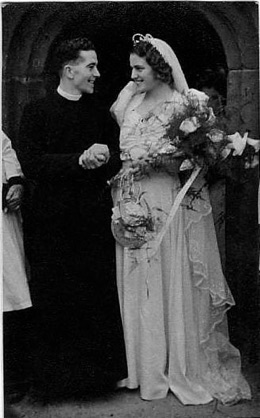
This excerpt has been trimmed to just the solo verse, sung by Christine
An entertainer of his skill inevitably made appearances in BFN (the British Forces Network) radio broadcasts. In 2006, one of my nieces had a quiet spell at work, and googled her late grandfather’s name to see if anything would come up. What she found is no longer available on the web now, but I managed to contact the originator of this delightful post who has given permission for me reproduce it, with no small amount of pride, here:
Trawling through a box of old photos, I came across these two, which look as if they must have been taken at a similar event...
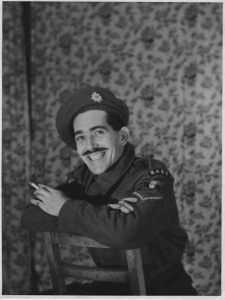
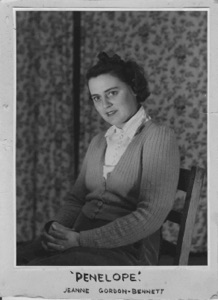
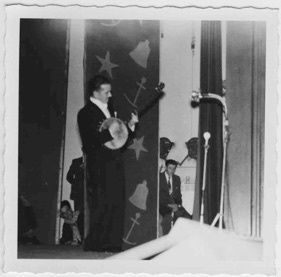
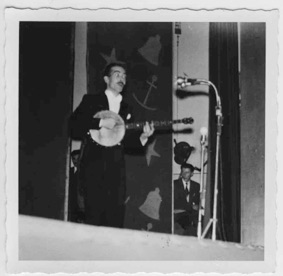
One of Jeanne’s tales of the firebombs was of an act of quiet heroism by Stanley. He must have been on fire-watch on an occasion when a firebomb had rolled down into the doorway of an air raid shelter. Donning his brand new leather gloves as protection, Stanley picked up the bomb and removed it to a place where it could cause less damage; in the process he ruined the gloves - a gift from Jeanne.
Another is the front cover of the Order of Service for the 'Dedication of the Church Premises' on Ascension Day 10th May 1956. I was there and still have the document as a memento of my association with your Dad and the church. Among the hymns used, selected by SGB, were 'O praise ye the Lord'; 'Christ is our cornerstone'; 'We love the place O God', verses of which were used as dedications were made at the font, the prayer desk, the lectern, the altar and the chancel step. The collection hymn was 'Thy hand O God has guided' (could this have been another touch of his sense of humour!). After the Blessing the choir sang 'God be in my head....'
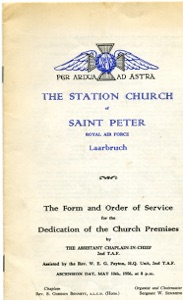
One is of a station football team in the 1956-7 era ... The gentleman on the right will be familiar to you.
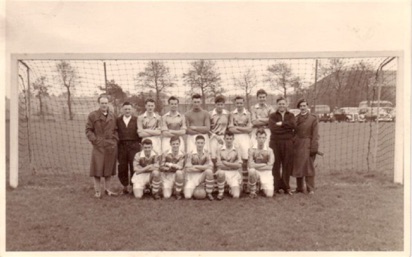
Are you aware that, prior to the dedication as a church premises, the building was the station gymnasium? The sanctuary area was blocked off by sliding doors when in use by the body builders! Now no longer a RAF station the church building went on to be a museum.
My other companion at the church at that time was the Choirmaster and Organist Sgt Bill Semmens, who took me through my paces on a couple of solo attempts as a bass. A memorable rendition he trained me for was "The People That Walked in Darkness" from "Messiah" which I sang a couple of times in St.Peter's as member of the choir and encouraged by SGB. Because of their guidance I have had opportunities to sing it on several other occasions over the years.
To that MSN post, Ron reinforced his original memories, as already posted, and generously added some more snippets, and illustrative photos.
Performing rights rules mean that I can’t include a recording of Stanley singing “Solitude” but here is a recording of him singing the recitative “And as Moses lifted up the serpent in the wilderness.” from Stainer’s “Crucifixion” - part of a rendition broadcast by BFN in Holy Week (April) 1957.
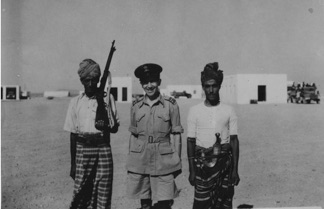
Aug. 2. 1973
My dear Stanley
A nice old couple we look - friendly
outreaching people - with-it types in the
best sense - keen to be identified with
modern forms of transport in up-to-the-
minute dress. Love to you all Edward Elien
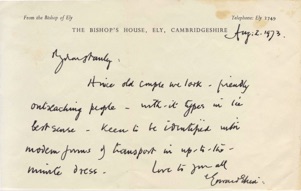
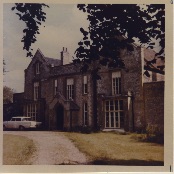
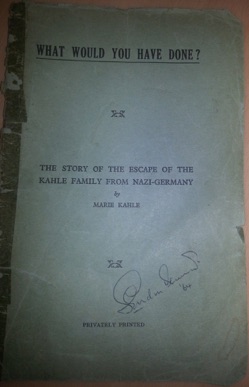
During our time in Cologne, we established links with the diplomatic community in Bonn, too. We have a copy of a very special book by Marie Kahle (1893-1948) - a notable woman, herself, and the wife of the eminent theologian and scholar of middle-eastern studies, Paul Ernst Kahle (1875-1964). It describes the spring 1939 escape of this non-Jewish family, which was being persecuted for having been friendly with, and supportive of, their Jewish friends, colleagues and acquaintances, especially after Kristallnacht.
Ours is a special copy, signed by many of their children, “In Deep Gratitude”, and making reference to 30 Sep 1964. My research, which tallies with my sister’s understanding, shows that Stanley was privileged to conduct the funeral of this eminent man - it took place, on that date, in the Schloßkirche of Bonn University.
This book has been placed in the protection of The National Holocaust Centre, north of Newark.
After RAF Laarbruch, Stanley was posted to RAF Halton - where he was to be 1-Wing chaplain (there were three “wings” of apprentices). His Arsenal experiences proved useful in training up the 1-Wing football team into a formidable force. A year or so before I started researching the family trees in earnest, I started to enquire whether people held any memories of my father, which I could use for this project. I was warmed to receive positive replies such as this relating to his time at RAF Halton:
In 1959/60 he spent eleven months away from us on an unaccompanied posting to Christmas Island, as it was then called (now called Kiritimati Island). By the time he was there, the nuclear tests had stopped, but the family was never convinced that he could have been entirely safe. On previous occasions, when separated from my mother for any length of time, he was inclined to suffer from skin rashes and the like. In the context of a Christmas Island posting, the need to spend some weeks in Hawaii hospital to deal with skin rashes takes on a more sinister feel.
all content on this web page © C M C, except where otherwise stated.
PLEASE NOTE - THIS WEBSITE IS IN DEVELOPMENT
When he got back he was clearly very ill. As a child, I was just pleased to get my “Daddy” back, but my mother was appalled to see him so thin: he resembled photographs of people who had suffered wartime imprisonment, with his ribs easily countable. He spent six months in hospital before returning to lighter duties at RAF Newton, in Nottinghamshire. Music, drama and sport proved their therapeutic worth. He played for the Southwell Diocese cricket XI and his local “Cassocks Eleven” cricket team would travel the area playing teams from the local pubs, having a lot of fun (the rules were carefully framed to ensure that!), and raising money for charity in the process. And here’s another of those delightful replies I received from Friends Reunited members - about RAF Newton:
Once again, he was posted to Germany - Cologne, this time. While there, our family was privileged to make friends with Gunther Karstedt, the local Lutheran military chaplain, whose church my father shared, and his family. This friendship has been nurtured by our attending their important family events, and their attending ours. This friendship endures to this day, with our families meeting up on almost every occasion we have holidayed in Germany, and careful maintenance of our Christmas card links.
In 1966 he returned to UK - to RAF Watton in Norfolk for a couple of years, before being posted to RAF Catterick. It was from Catterick that he retired from the RAF. Some weeks before his retirement, he received a letter from the Bishop of Ely, Edward J K Roberts, whom he had first got to know all those years earlier in the Portsmouth Diocese. It was an invitation to set up a group of parishes in west Norfolk. Stanley thought he must be mad - and said so! - since he had no experience of being a parish priest, having gone straight from curacy and precentorship, into the RAF. The Bishop was wise enough to know his man, and my father made a great job of the task he was given. He was careful to respect the individual characters of each community, setting up a group council, consisting of the clergy and the churchwardens, to organise the way that the different individual parishes could interact.
We also got to live in the beautiful C17th Fincham Rectory - a building we’d made detours in order to pass within view, on the way from RAF Watton back to my boarding school, some years before.
One of my favourite Norfolk anecdotes arose from Stanley’s humorous relationship with the local GP. The GP was firmly atheist, but my father had to be in touch with him a lot in order to keep his gastric ulcer under control (in the days before it was realised that treatment could realistically be effected with antibiotics). My father would introduce himself over the phone with “Hello. This is Mumbo Jumbo of Mumbo Jumbo Ltd!”. One day, the GP made an unscheduled visit to the Rectory: he had felt impelled to share with my father the fact that he and his health visitors had realised that, wherever my father’s ministry overlapped with their practice, the prescriptions of tranquillisers had dropped so much as to be significantly noticeable. My recollection of the original tale was that he had spoken of a 30% reduction (with a faint possibility that the figure was significantly higher than that).
In 1973, Ely Cathedral celebrated its thirteenth centenary, with a series of events. They had a notional “beating of the bounds” of the diocese, whereby the bishops visited all the boundary parishes, and met with the people there - visiting schools and suchlike, and being entertained. For the set of events in the Fincham area, he asked Stanley to be his chaplain (i.e. a kind of P.A.). My father decided to wear his (rather fetching) Spanish wide-brimmed hat (think sherry advertisements!). The Bishop asked why, but was completely convinced by my father’s explanation: Stanley was not tall, and would be a be-cassocked figure amongst lots of be-cassocked figures; if the Bishop needed to find him, he would have only to look for the hat.
(The photo has been treasured by my mother, and had faded badly - and stuck to the glass of the frame. Behind the photo, I found a typically humorous note from the Bishop - reproduced here by kind permission of Sir Hugh Roberts)
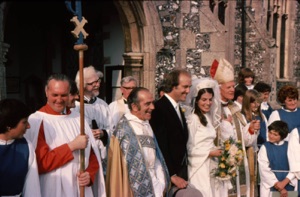
It was at Fincham that my husband and I were married. We were fortunate to be able to have such a special event. My father, Stanley, celebrated the marriage, with a special family friend “giving me away”. The Bishop was kind enough to celebrate the wedding communion, and we had both the local choir (with whom I sang when at home) and organist, and the choir of Christ Church, Lancaster Gate (with whom I sang when at work in London), and their director of music, Roderick Swanston. The ladies of the parish all excelled themselves with their individual flower arrangements, and the whole community gave us a warm send-off. (One lady even moved her regular Saturday morning hair appointment to Friday, so that I could have my hair done on The Morning.)
After about eight years there, my father decided that it was time to move on: any future plans would demand more years of energy than he thought he could offer. He moved on to become Rector of Gamston, in Southwell diocese. While there, he was due to celebrate the fortieth anniversary of his ordination 18 May 1980. As Easter 1980 approached, he began to suffer unexplained pains in his back, and in his jaw. At first this was attributed to arthritis, but on Ascension Day, he took up a short-notice non-appointment meeting with the consultant. The pain was getting unmanageable, and a shadow on his lung looked as if the years of smoking were taking their penalty. He was in hospital for the 18 May - but we were able to take him the various special gifts for him to enjoy. By Whitsun, he was in Weston Park Hospital in Sheffield, but their expertise made it very clear that time was very short, and he died on Trinity Sunday 1980 - his fortieth anniversary day, according to the church’s calendar, and a beautiful sunny morning. It was only after his death that the consultant was able to tell us that the primary had been in his adrenal gland: an extremely rare starting point for cancer.
His funeral was a great celebration of his life. The whole family was touched by the efforts that people made to attend. The Bishops and local clergy were there in force. Just as they had done for our wedding, the Karstedt family from Germany travelled over to be with us; the retired Bishop of Ely, who had been attending a conference in Cambridge made the additional trek up to north Nottinghamshire to be with us, instead of (as we had thought would be reasonable) going straight home to the Isle of Wight. We were also made aware that there would be people in other places celebrating his life at the same time as we did: a special service in Hawaii Cathedral (twenty years after he had been there!) and a simultaneous (i.e. night hours) service in the Cathedral in Fiji where Bishop Jabez Brice (by 2008, he was Anglican Archbishop of Polynesia) still held him in affection.
After Stanley’s death my mother didn’t want lots of money spent on flowers - however beautiful - and requested donations for Weston Park Hospital’s Day Care Unit Appeal. By 5 August, the Appeal Co-ordinator wrote to say that the total of donations given in memory of Stanley stood at almost £800. (At the turn of 1980/81, the RPI was about 70 - by Jun 2012 it was over 240.)
We received numerous letters of condolence - as one might expect. But they were full of loving memories of what Stanley had done for people over the years: marriages rescued, vocations found, lives put back on the rails... and of the fun and laughter he’d shared with people. We still have those letters: they are much too precious to be put into the paper recycling!
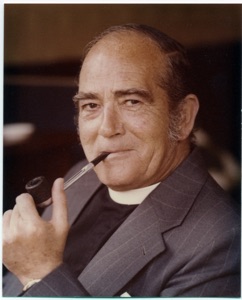
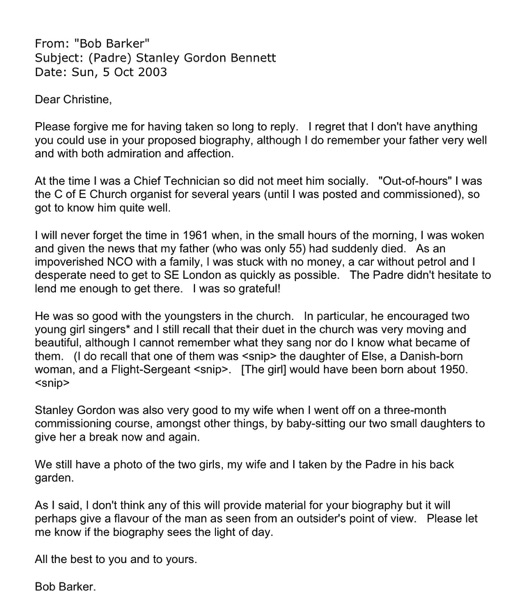
*I believe that the singing girl, about whom Bob wasn’t sure, was probably myself.
It was as the climax of the celebrations that a service was held on a glorious sunny June afternoon. The Archbishop of Canterbury, Michael Ramsay, attended (taking a moment to gaze up into the lantern - perhaps remembering his days as a choirboy there), as did the Bishops from the twinned diocese in Denmark. The cathedral would be full - but the Bishop didn’t want some solemn - and dull - service; he wanted a real explosion of joy to celebrate those thirteen centuries of Christianity. He recruited my father to organise a kind of “warm-up act”, so that the congregation would be entertained before the service. My father recruited me, and I recruited a university friend and, between us, we kept the congregation occupied and ready to welcome the Archbishop with cheers and applause as the service started in earnest.
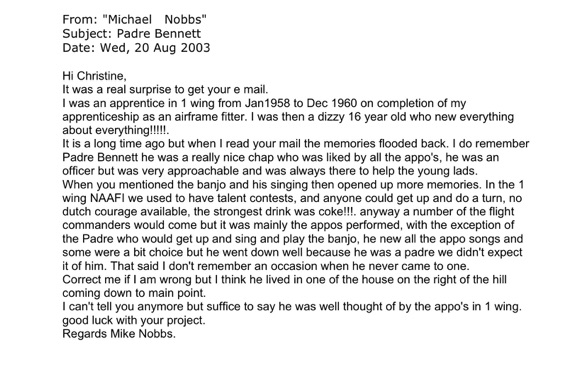
This is a photo taken at Fincham and is, perhaps, how many will remember him... that gentle grin, with laughter ever ready to break out.
Stanley G Bennett - a fine priest, a fine musician, entertainer and sportsman, and a special man.
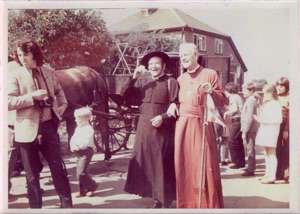

Line-drawing of Fincham Rectory, by P R B Cocks, based on a photograph
by C M Cocks
Towards the end of June, a service of thanksgiving for his life and ministry was held at St Martin’s, Fincham. Once again, many people came along, even though it was already a couple of years since he’d left. Hubert Ward, Headmaster of King’s School, Ely, gave the address, speaking movingly of his positive experiences of how his life had intersected with my parents’: once at a time of personal trouble, once as part of the Ely 13th Centenary celebrations (when the School had performed A Midsummer Night’s Dream in the back garden of the Rectory), and then when he and his wife had joined in the celebrations of our wedding. After the service, Hubert handed his text to my mother. He has kindly given me permission to quote from his words...
“And speaking of Stanley’s magic, I cannot forget the culmination of the Bishops’ Walk when a packed Mother Church of the Diocese throbbed to the rhythm of guitars and swelled with the sound of two thousand voices, waiting for the arrival of their Archbishop. I had had a hand, with my senior pupils, in getting those two thousand people into place, but it was Stanley Bennett, and Christine, who enabled those people to greet the Primate of All England. And greet him we did.
“But speaking for myself, speaking, as I am proud to do, for Fincham, speaking, as I am sure I do, for the Diocese, we are proud to have known such a man
A parish priest, a wise friend and a great personality.
For myself, I count myself fortunate to have met him, to have known him, and in some small measure, to have worked with him.”
...and ...



This email gives an indication of how his ministry in Christmas Island was valued... John Sutcliffe had remembered my father after a posting 57 years ago, and 37 years after my father’s death. He had felt moved to look him up online, to see what he might find. Finding this page, he made the effort to contact me with this wonderful (and precious to us) tribute, which he has generously permitted me to share ...
